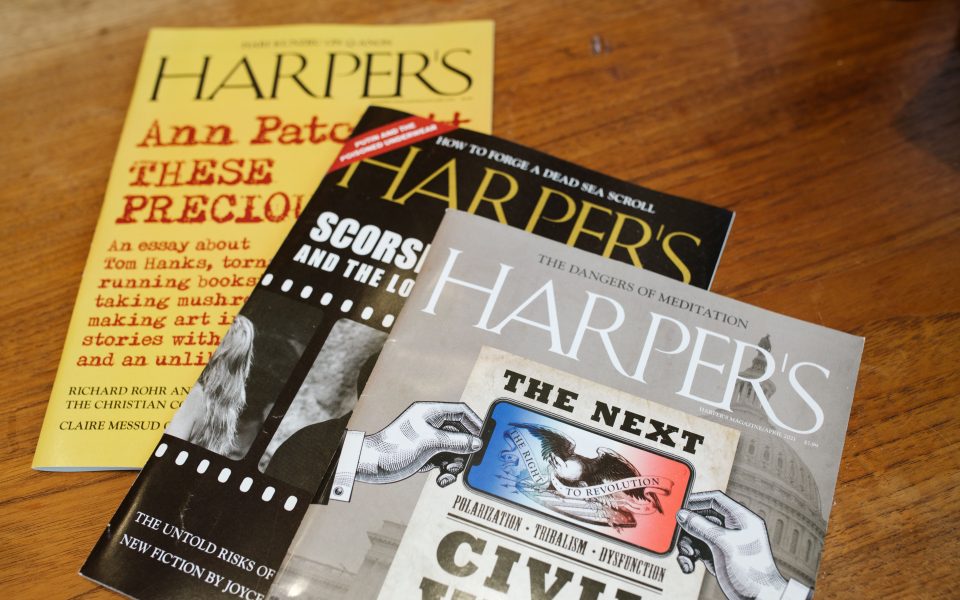Inside America’s most interesting magazine, and media’s oddest workplace

Last August, when the pandemic seemed endless, John R. MacArthur, the publisher of Harper’s, asked his doctor about the virus.
“I haven’t seen a case in three months,” his doctor told him. MacArthur ordered up some office air filters, put arrows on the floor and brought his small staff back to work.
“We’re better off working together,” he told me in an interview inside Harper’s headquarters, an underpopulated warren on Broadway north of Houston Street, in mid-March. “And I’m happier here.”
What has ensued at Harper’s since last summer is a kind of hostage situation, in which the magazine’s 17 newsroom staff members reluctantly trudge into work, try to keep office windows open and Zoom one another from their desks.
The situation, widely viewed internally as insane, makes complete sense to those familiar with the recent history of the magazine. Harper’s first published an excerpt from “Moby Dick” in 1851, but has had a difficult couple of decades, sinking into obscurity as MacArthur battled the rising digital tide and his own staff. Now, Harper’s is the weirdest place to work in New York media and yet an unexpectedly excellent magazine that stands out in part because of its wide range, in style and substance, amid a homogenizing media landscape.
And among the surprises is its complicated relationship with its most famous recent product, the letter it published last year from writers and others decrying what they called “the intolerant climate that has set in on all sides.”
To describe MacArthur, 64, as unlike most modern media publishers does not quite capture his unusual role. His paternal grandfather built the insurance and real estate fortune that produced MacArthur “genius” grants. He reads six print newspapers daily, including Le Monde, which he has printed and delivered every day by a special service. (His mother was French, and he is bilingual.)
When I met MacArthur, he was dressed in a classic style of the American rich, which is to say, indifferently, in a sport jacket, dark slacks, battered black shoes and a surgical mask. MacArthur earns $20,000 a year as the publisher of Harper’s, and his family foundation fully funds the nonprofit that has published the magazine since he rescued it from bankruptcy in 1980.
Back then, he brought back Lewis Lapham, the patrician and erudite editor, who created signature features like “Harper’s Index,” while making the magazine a destination for great writers and unapologetically left-wing journalism. The magazine’s unpaid internship was a legendary path to magazine glory. When I got out of college in 1999, I envied a friend who landed one. Harper’s was then, with The New Yorker and The Atlantic, one of the three great general-interest American magazines. And for a moment in the early 2000s, Harper’s became a central voice of the American left after it took a strident line against war in Iraq, while The New Yorker supported the invasion and The Atlantic published many arguments for it.
Then came the internet. MacArthur told the staff in the early aughts that the new technology “wasn’t much more than a gigantic Xerox machine.” While his rivals innovated and experimented, he simply turned the nose of the plane directly toward the earth, putting the magazine behind a hard paywall in 2003 and doing nothing to market digital subscriptions.
After Lapham departed in 2006, Harper’s drew attention mainly for its internal eruptions. MacArthur has switched top editors six times since 2010. Employees organized a union in that year, in a direct challenge to his management. MacArthur dug in, fighting it for years before triumphing in 2015, when the employees remaining in the bargaining unit voted to pull out of the union.
By then, Harper’s had dropped almost entirely out of the political and cultural conversation. But if you were a young editor who aspired to publish great work, or a famous writer who wanted to get paid for something ambitious and unconventional, Harper’s never really went away. And MacArthur kept donating more than $4 million a year without complaint.
Despite his losses over decades of ownership, MacArthur, several former staff members said, has never insisted on controlling the magazine. His attention is often elsewhere, particularly in Paris. He writes in French for Le Monde Diplomatique, travels often and has absorbed the current French sense of horror at American cultural politics. At Harper’s, he occasionally makes notes on print issues or suggests curious items for its front-of-the-book “Readings” section.
A major exception came in 2018, when he demanded a broadside against what he has described elsewhere as the “the worst excesses of the #MeToo movement,” including the circulation of a list of anonymous allegations against men in media. But instead of changing the narrative, Harper’s became the news, blundering into a messy prepublication Twitter debate over whether it had intended to publish the name of the woman who had compiled the list. Inside Harper’s, too, two former employees told me, the article was seen as the unfortunate cost of working for MacArthur. The editor at the time, James Marcus, wrote an editor’s note declaring himself “impossibly ambivalent” about the tension between the danger of anonymous allegations and the need of women to defend themselves in the workplace, according to a draft I obtained. MacArthur rejected the language and soon fired Marcus.
While editors came and went, MacArthur remained serenely in the corner office. In 2019, MacArthur gave the top job to Christopher Beha, a former Harper’s intern who had been living in Paris writing a darkly comic novel about the post-9/11 American media. And so last July, when another American expatriate in Paris, Thomas Chatterton Williams, was looking for a place to publish a broadside against the “intolerant climate” to which some of the most famous writers in the world — Salman Rushdie, J.K. Rowling and Margaret Atwood, among others — had signed their names, he emailed Beha. The letter was already finished and approved, but MacArthur liked it enough to add his name, and Beha published it in full online.
It was, for Harper’s, a sensation, receiving 2.5 million views. The magazine — whose paywall is now more porous, but is still years behind the kind of digital subscription machine that drives The New Yorker and The Atlantic — grew its subscription base 13% and bounced back above 100,000 subscribers. It is still far down from a peak of 231,670 during the George W. Bush years, and so far from breaking even that MacArthur told me he hadn’t done the math of what it would take to get there.
The Harper’s staff, since MacArthur broke the union, is not a rebellious bunch. No current staff member would speak to me on the record about the magazine. But when the letter appeared on the website, they revolted, and in an emotional Zoom meeting on July 8 (they weren’t yet back at the office), Beha took responsibility for publishing the letter and defended it. A former Harper’s assistant editor who is now a New Yorker fact checker, Shirley Ngozi Nwangwa, recalled that editors argued that regardless of its intent, the letter would be used “as ammunition against the racial justice protests.”
Beha also told the Harper’s employees they were free to speak up on social media against the letter; an editor responded that they feared MacArthur would fire them if they did. The next day, Beha wrote an elliptical email that didn’t mention MacArthur, but acknowledged that he had been trying to “make the parts of the office that are under my control as open, respectful and tolerant of difference as I could, while insulating my staff as much as possible.”
Harper’s didn’t publish the letter in print until October, packaging it with several scathing attacks on it and one signatory’s apology for signing. In an editor’s note, Beha wrote that the attacks themselves were an instance of the kind of debate the letter supported, and that “in that sense, even the letter’s loudest critics were in a kind of agreement with it.”
There are two ways to read the Harper’s letter. One is to see it as a rejection of elements of the protests against racism, and a direct rejoinder to claims that some speech is physically dangerous. That’s how it was read by many of the Harper’s editorial staff members who opposed it, and also apparently how it was read by MacArthur, who signed it.
Though he has contributed to Harper’s only twice over 40 years, MacArthur writes an occasional column in French for the Montreal newspaper Le Devoir. (In another Harper’s oddity, the column is translated back into English by someone else, then published without further editing on the Harper’s website.) There, MacArthur described the letter as “a public stand against political correctness and ‘cancel culture.’ ” Earlier this month, he denounced the “McCarthyism and mob rule” at work when The New York Times forced out a veteran journalist who had used a racial slur on a trip with teenagers to Peru. MacArthur wrote the word in full, “a matter of honor, as a matter of principle, to use it informationally like he did,” he told me.
But MacArthur’s columns don’t appear in the print magazine. Relatively little railing against cancel culture does. And indeed, there’s also another way to read the Harper’s letter, which is simply its plain language, which called for a “culture that leaves us room for experimentation, risk taking, and even mistakes.” That’s how Beha said he has strained to interpret it, and why he’s avoided taking Harper’s down an overtly reactionary — if commercially promising — path.
“We’re truly committed to publishing heterodox stuff and surprising people, but we’re not beating a cancel culture drum,” he said at the interview with him and MacArthur. He tried at times to steer his boss’s views, and appeared to start vibrating with stress when I asked about staff members’ views about being required to come to work during the pandemic. “We’re not trolling.”
Williams, now a Harper’s columnist, said Harper’s was “not anti-woke but is simply not woke.”
Perhaps the strangest thing about this strange magazine is that it’s working — whether in spite of MacArthur or because of him. Or, as current and former Harper’s employees told me, it could be out of the strange sense of solidarity that he has inadvertently created among the editors who see themselves as caretakers of a great institution.
The January cover featured perhaps the best piece of first-person writing on the pandemic, Ann Patchett’s uncategorizable, 20,000-word “These Precious Days,” which is about storytelling, death, Tom Hanks, Tom Hanks’ personal assistant and psychedelic mushrooms. Other major recent features include Naomi Jackson’s meditation on giving birth while Black, two essays questioning whether American democracy can survive, a warning that meditation may lead to suicide and an article about a woman who talks to crows. Two recent covers feature the director Martin Scorsese raging that “the art of cinema is being systematically devalued” in favor of “content,” and the writer Lena Dunham reckoning with her inability to bear children.
Central to some of Harper’s best work are stories of dislocation rooted in a basic skepticism of the American free market. Chloé Zhao’s film “Nomadland,” which tells the story of Americans who can’t afford to retire roaming the country in RVs and working seasonal shifts at Amazon warehouses, began its life as a feature in Harper’s in 2014 about “geriatric migrant labor.”
“Among prestige publications at the present moment, race, gender and sexuality are the big three,” said the chairman of the Harper’s board, Andrew Bacevich, who is a professor emeritus of international relations and history at Boston University. “I’m not saying that’s wrong — I am saying that Harper’s tends to represent a different view. It’s a reminder that class still matters.”
Among Harper’s many contradictions is that a magazine with such powerful purchase on the story of America’s class divides is also a vehicle for them. MacArthur’s generosity doesn’t extend to interns, who are still unpaid — a practice his spokesperson maintained is legal because the program is a nonprofit educational initiative. Junior staff members earn salaries you can’t live on in New York.
Nwangwa told me she’d loved the ambition and generosity of the editors. But she was making $37,000 a year with no immediate prospect of a raise. And, she thought, she was likely to remain the only Black editorial staffer at a place that relied on people who didn’t need the money. On her last day, MacArthur popped by her cubicle genially, sending her diving for her face mask, and asked her what The New Yorker was going to pay her.
“Well that’s too bad,” she recalled him saying when she told him. “You know we can’t pay anybody close to that here.”
[The New York Times]






